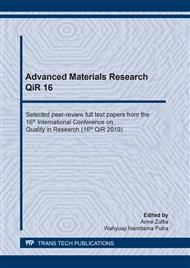p.233
p.238
p.248
p.257
p.265
p.272
p.278
p.285
p.293
The Role of Anionic Surfactant to the Particle Size Reduction of Conductive PANi
Abstract:
The conductive polyaniline (PANi) with fine particles of sizes from 724 nm down to 191 nm has been successfully synthesized through chemical oxidation reaction. The synthesis of PANi was carried out in acidic media under HCl 1.5 M solution using ammonium persulphate (APS) as an oxidizing agent in the presence of anionic surfactants. Two different types of surfactant respectively Sodium Octyl Sulphate (SOS) and Sodium Dodecyl Sulphate (SDS) were brought into an investigation on the effect of the surfactant chain length of C8 and C12 to the particle size formation. Such molecular chain length is responsible for the particle size growth rate. It was found that the average particle size of PANi decreased gradually by the addition of SOS and SDS surfactants with 1 % concentration each. The particle of PANi with sizes 296 nm and 191 nm was obtained as analyzed by Particle Size Analyzer (PSA). These sizes are far below 724 nm, which obtained from the same reaction but with surfactant free. Other supporting indicators showed that the pH of reaction solution was somewhat more acidic after 7 hours of reaction when the surfactant with pH value range within 0.7 – 1.4 presence. The temperature of solution increased with time following the energy released reached 30-31°C within the first 30 minutes, which was lower when compared with that of surfactant free.
Info:
Periodical:
Pages:
265-271
Citation:
Online since:
July 2020
Price:
Сopyright:
© 2020 Trans Tech Publications Ltd. All Rights Reserved
Share:
Citation:


